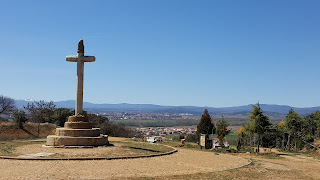
I woke refreshed; I had actually slept very well
for a change, with no sinus problems or headaches! The walk from Mazarife to
Astorga took 8 hours and 40 minutes, but that was partly because we were wandering
along and taking our time as usual. Our original plan had been to only walk to
Hospital de Órbigo, but we found that when we got
there, we still felt fresh and decided to walk on to Astorga.
 |
| Felt arch support |
The first section to Villavante was hard – the path
was straight, stony and monotonous and my left foot was still really hurting
due to arch strain from the excessive pronation. At Villavante however, we had
second breakfast and I constructed a felt arch support that I taped underneath the
insole of my walking shoe. This did the trick and the pain in my foot quickly
settled down and I no further problems for the rest of the trip.
 |
| David drying his socks near Villavante! |
We had a pleasant walk to Hospital de Órbigo, stopping
occasionally, to watch foraging Storks, who were following the tractors
ploughing in nearby fields in just the same way that Gulls do in Ireland.
 |
| The bridge at Hospital de Orbigo |
At Hospital we paused to admire the bridge; the longest
and best preserved medieval bridge in Spain according to John Brierley. Built
in the 13th century on earlier Roman foundations, it is famous as
the site of a famous jousting tournament that lasted from July 10th –
August 9th1434 and which has given the
bridge it’s nickname – el Passo Honroso. A
noble knight from León, Don Suero de Quiñones,
who had been spurned by a noble lady, declared himself imprisoned by his love
for her and calling on St. James as his witness, vowed to break 300 lances as a
ransom to escape from his ‘prison’. Knights came from all over Europe to take
up his challenge and afterwards Don Suero travelled to Santiago and offered a
gold bracelet belonging to the lady in thanksgiving which has become associated
with the collar that adorns the reliquary bust of St. James in Santiago
cathedral.
 |
| Monument to Don Suero on the bridge |
The bridge was also the site of battles between the
Visigoths and Swabians in 452 and later, when Alfonso III ‘The Great’ confronted
the Moors in about 900.
Apart from the bridge, the town of Hospital turned
out to be smaller than I had expected, so we walked on and had lunch in a bar
at Santibanez de Valdeiglesia. On the way, we met two middle aged Belgian
ladies who were starting their Camino at Hospital and fell into conversation
with them.
The last section to Astorga was very beautiful with
gently rolling hills covered in woodland, open fields and vineyards. We saw beautiful
yellow butterflies and spotted a large green lizard and the snow-capped Montes
de León could be seen in the distance.
 |
| Cruceiro Santo Toribo with Astorga in the background |
Eventually, we reached the hill on which stands the
stone Cruceiro Santo Toribo and
looked down on the small city of Astorga. The stone cross marks the site where
Bishop Toribio of Astorga is said to have shaken the dust from his sandals in the
5th century as he looked back at the city for the last time when he
was forced to leave his diocese.
Astorga turned out to be a beautiful little city
nestled within it’s ancient city walls. It is the capital of the Maragato region
– the Maragatos being a distinct
ethnic group with their own customs, language and traditional dress, who in
the past made their living by guiding pilgrims through the dangerous Montes de León.
 |
| San Javier |
We made our way into the old city through the
Puerta Sol and along the narrow streets to Albergue San Javier, close to the
cathedral – a evocative converted traditional 3 storey house, with creaky
timber floors, stairs and beamed ceilings that had a pervading smell of wood
smoke, which was permeating through the house from a wood burning stove on the
ground floor. The Fire Officer in David was not impressed with the fire safety
aspects of the accommodation, but as usual the Pilgrim in David came to the
fore and these concerns were put to one side!
 |
| Cathedral viewed from San Javier |
After showering and laundry we briefly explored the
city. We admired the beautifully ornate Baroque façade of the cathedral, its’
features being highlighted in the evening sun and wandered through the old
city, stopping to admire some Roman mosaics in an excavated Roman house that is
on view near Plaza San Francisco.
 |
| Roman mosaic |
Nearby in the building adjoining the church,
a religious Confraternity were busy organising their pasos or religious floats for the forthcoming Semana Santa (Holy
Week) processions. Each paso was highly ornate with life-size holy statues
showing tableaus of scenes such as the crucifixion or the descent from the
cross. The organisers kindly invited us in and allowed us to examine the pasos at
close quarters.
 |
| One of the pasos |
The day finished off with dinner in a restaurant in
the Plaza Mayor, where we met the two English ladies we had talked to at
Mazarife and we were also joined by an Austrian female pilgrim. I had pulpo –
octopus stew, as a starter. Well we were nearly in Galicia, so it had to be
done and I did enjoy it!
 |
| Pulpo! |












